Field Testing of an Acoustic Method for Locating Air Leakages in Building Envelopes †
Abstract
1. Introduction
2. Methods
2.1. Test Site
2.2. Measurement Setup
2.3. Acoustic Air Leakage Detection
2.4. Evaluation and Categorization of Acoustic Signals
2.5. Evaluation of Spectral Properties
3. Results and Discussion
3.1. Examples of Detected Air Leakages
3.2. Evaluation of the Acoustic Signals of the Measured Rooms and Buildings
3.3. Examples of the Spectral Properties of Leakages
4. Conclusions
5. Patents
Author Contributions
Funding
Data Availability Statement
Acknowledgments
Conflicts of Interest
Abbreviations
| AAS | Acoustic assessment score |
| MFAS | Multi-frequency assessment score |
| Pl | Potential leakage |
| UAV | Unmanned aerial vehicle |
References
- Hurel, N.; Leprince, V. VIP 46: Building Airtightness Impact on Energy Performance (EP) Calculations; AIVC Ventilation Information Papers. 2023. Available online: https://www.aivc.org/sites/default/files/VIP_46.pdf (accessed on 14 April 2024).
- Poza-Casado, I.; Meiss, A.; Padilla-Marcos, M.A.; Feijó-Muñoz, J. Airtightness and energy impact of air infiltration in residential buildings in Spain. Int. J. Vent. 2021, 20, 258–264. [Google Scholar] [CrossRef]
- Jokisalo, J.; Kurnitski, J.; Korpi, M.; Kalamees, T.; Vinha, J. Building leakage, infiltration, and energy performance analyses for Finnish detached houses. Build. Environ. 2009, 44, 377–387. [Google Scholar] [CrossRef]
- Kalamees, T. Air tightness and air leakages of new lightweight single-family detached houses in Estonia. Build. Environ. 2007, 42, 2369–2377. [Google Scholar] [CrossRef]
- Jones, B.; Das, P.; Chalabi, Z.; Davies, M.; Hamilton, I.; Lowe, R.; Mavrogianni, A.; Robinson, D.; Taylor, J. Assessing uncertainty in housing stock infiltration rates and & associated heat loss: English and UK case studies. Build. Environ. 2015, 92, 644–656. [Google Scholar] [CrossRef]
- ISO 9972:2015; Thermal Performance of Buildings—Determination of Air Permeability of Buildings—Fan Pressurization Method. International Organization for Standardization: Geneva, Switzerland, 2015.
- ASTM E1186-22; Standard Practices for Air Leakage Site Detection in Building Envelopes and Air Barrier Systems. American Society for Testing and Materials: West Conshohocken, PA, USA, 2022. [CrossRef]
- Barreira, E.; Almeida, R.M.; Moreira, M. An infrared thermography passive approach to assess the effect of leakage points in buildings. Energy Build. 2017, 140, 224–235. [Google Scholar] [CrossRef]
- Lerma, C.; Barreira, E.; Almeida, R.M. A discussion concerning active infrared thermography in the evaluation of Buildings Air Infiltration. Energy Build. 2018, 168, 56–66. [Google Scholar] [CrossRef]
- Mahmoodzadeh, M.; Gretka, V.; Wong, S.; Froese, T.; Mukhopadhyaya, P. Evaluating Patterns of Building Envelope Air Leakage with Infrared Thermography. Energies 2020, 13, 3545. [Google Scholar] [CrossRef]
- Kölsch, B.; Pernpeintner, J.; Schiricke, B.; Lüpfert, E. Air leakage detection in building façades by combining lock-in thermography with blower excitation. Int. J. Vent. 2023, 22, 357–365. [Google Scholar] [CrossRef]
- Ghazi, C.; Marshall, J. A CO2 Tracer-gas method for local air leakage detection and characterization. Flow Meas. Instrum. 2014, 38, 72–81. [Google Scholar] [CrossRef]
- Cardoso, V.E.M.; Pereira, P.F.; Ramos, N.M.M.; Almeida, R.M.S.F. The Impacts of Air Leakage Paths and Airtightness Levels on Air Change Rates. Buildings 2020, 10, 55. [Google Scholar] [CrossRef]
- Zheng, X.; Cooper, E.; Gillott, M.; Wood, C. A practical review of alternatives to the steady pressurisation method for determining building airtightness. Renew. Sustain. Energy Rev. 2020, 132, 110049. [Google Scholar] [CrossRef] [PubMed]
- Keast, D.N.; Pei, H.S. The use of sound to locate infiltration openings in buildings. In Proceedings of the ASHRAE-DOE Conference on the Thermal Performance of the Exterior Envelope of Buildings, Kissimmee, FL, USA, 3–5 December 1979. [Google Scholar]
- Sonoda, T.; Peterson, F. A sonic method for building air-leakage measurements. Appl. Energy 1986, 22, 205–224. [Google Scholar] [CrossRef]
- Iordache, V.; Catalina, T. Acoustic approach for building air permeability estimation. Build. Environ. 2012, 57, 18–27. [Google Scholar] [CrossRef]
- Catalina, T.; Iordache, V.; Iordache, F. Correlation between air and sound propagation to determine air permeability of buildings for single/double wood pane windows. Energy Build. 2020, 224, 110253. [Google Scholar] [CrossRef]
- Hassan, O.A. An alternative method for evaluating the air tightness of building components. Build. Environ. 2013, 67, 82–86. [Google Scholar] [CrossRef]
- Berardi, U.; Pouyan, S. Exploring acoustical approaches for pre-screening the airtightness of building enclosures. Proc. Meet. Acoust. 2018, 35, 040005. [Google Scholar] [CrossRef]
- Graham, R.W. Infrasonic Impedance Measurement of Buildings for Air Leakage Determination. Master’s Thesis, Syracuse University, Syracuse, NY, USA, 1977. [Google Scholar]
- Card, W.H.; Sallmann, A.; Graham, R.W.; Drucker, E.E. Infrasonic measurement of building air leakage: A progress report. In Building Air Change Rate and Infiltration Measurements; ASTM International: West Conshohocken, PA, USA, 1980; pp. 73–88. [Google Scholar] [CrossRef]
- Kölsch, B.; Walker, I.S.; Schiricke, B.; Delp, W.W.; Hoffschmidt, B. Quantification of air leakage paths: A comparison of airflow and acoustic measurements. Int. J. Vent. 2021, 22, 101–121. [Google Scholar] [CrossRef]
- Kölsch, B.; Tiddens, A.; Estevam Schmiedt, J.; Schiricke, B.; Hoffschmidt, B. Detection of air leakage in building envelopes using ultrasound technology. In Proceedings of the Whole Building Air Leakage: Testing and Bulding Performance Impacts, San Diego, CA, USA, 8–9 April 2018; ASTM Committee: Philadelphia, PA, USA, 2019; pp. 160–183. [Google Scholar] [CrossRef]
- Chiariotti, P.; Martarelli, M.; Castellini, P. Acoustic beamforming for noise source localization—Reviews, methodology and applications. Mech. Syst. Signal Process. 2019, 120, 422–448. [Google Scholar] [CrossRef]
- Raman, G.; Chelliah, K.; Prakash, M.; Muehleisen, R.T. Detection and quantification of building air infiltration using remote acoustic methods. In Proceedings of the INTER-NOISE and NOISE-CON Congress and Conference, Melbourne, Australia, 16–19 November 2014. [Google Scholar]
- Kölsch, B.; Schiricke, B.; Lüpfert, E.; Hoffschmidt, B. Detection of Air Leakage in Building Envelopes using Microphone Arrays. In Proceedings of the 41st AIVC/ASHRAE Conference, Air Infiltration and Ventilation Centre (AIVC), Athens, Greece, 13–15 September 2021. [Google Scholar]
- Holstein, P.; Bader, N.; Moeck, S.; Münch, H.J.; Döbler, D.; Jahnke, A. Akustische Verfahren zur Ermittlung der Luftdichtheit von Bestandsgebäuden. In Denkmal und Energie 2020; Springer: Wiesbaden, Germay, 2019; pp. 111–123. [Google Scholar] [CrossRef]
- Schiricke, B.; Kölsch, B. Acoustic method for measurement of airtightness—Field testing on three different existing office buildings in Germany. In Proceedings of the 43rd AIVC conference. Air Infiltration and Ventilation Centre (AIVC), Copenhagen, Denmark, 4–5 October 2023; pp. 53–62. [Google Scholar]
- Groesdonk, P.; Kölsch, B.; Schiricke, B.; Estevam Schmiedt, J.; Patel, N.; Hoffschmidt, B. Innovative contact-less measurement technologies for building energy performance assessment: A pilot study. J. Build. Perform. Simul. 2024. [Google Scholar]
- Döbler, D.; Heilmann, G.; Schröder, R. Investigation of the depth of field in acoustic maps and its relation between focal distance and array design. In Proceedings of the 37th International Congress and Exposition on Noise Control Engineering. Institute of Acoustics—Chinese Academy of Sciences, Shanghai, China, 26–29 October 2008. [Google Scholar]
- gfai tech GmbH. Software: NoiseImage, Version 4.13.4.17964; GmbH: Berlin, Germany,, 2021.
- Jaeckel, O. Strengths and weaknesses of calculating beamforming in the time domain. In Proceedings of the 8th Berlin Beamforming Conference, GFaI e.V., Berlin, Germany, 22–23 November 2006. [Google Scholar]
- Teutsch, H. Modal Array Signal Processing: Principles and Applications of Acoustic Wavefield Decomposition; Springer: Berlin/Heidelberg, Germany, 2007. [Google Scholar]
- Prignon, M.; Van Moeseke, G. Factors influencing airtightness and airtightness predictive models: A literature review. Energy Build. 2017, 146, 87–97. [Google Scholar] [CrossRef]
- Mélois, A.; Moujalled, B.; Guyot, G.; Leprince, V. Improving building envelope knowledge from analysis of 219,000 certified on-site air leakage measurements in France. Build. Environ. 2019, 159, 106145. [Google Scholar] [CrossRef]

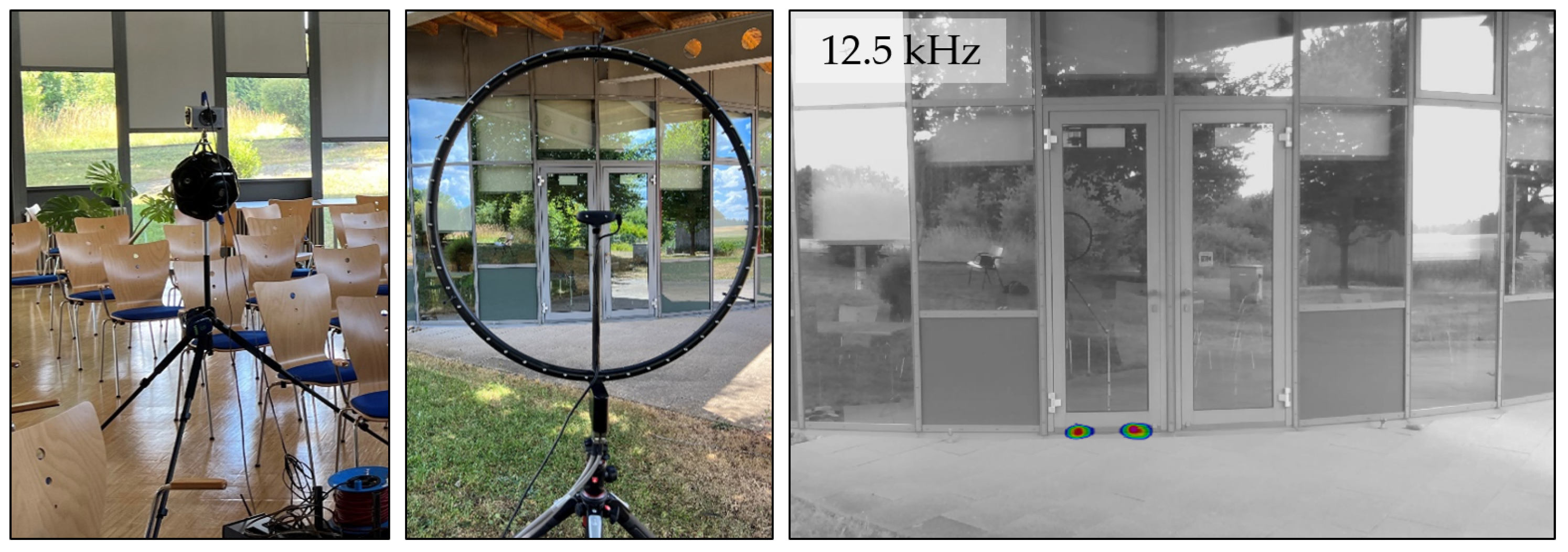
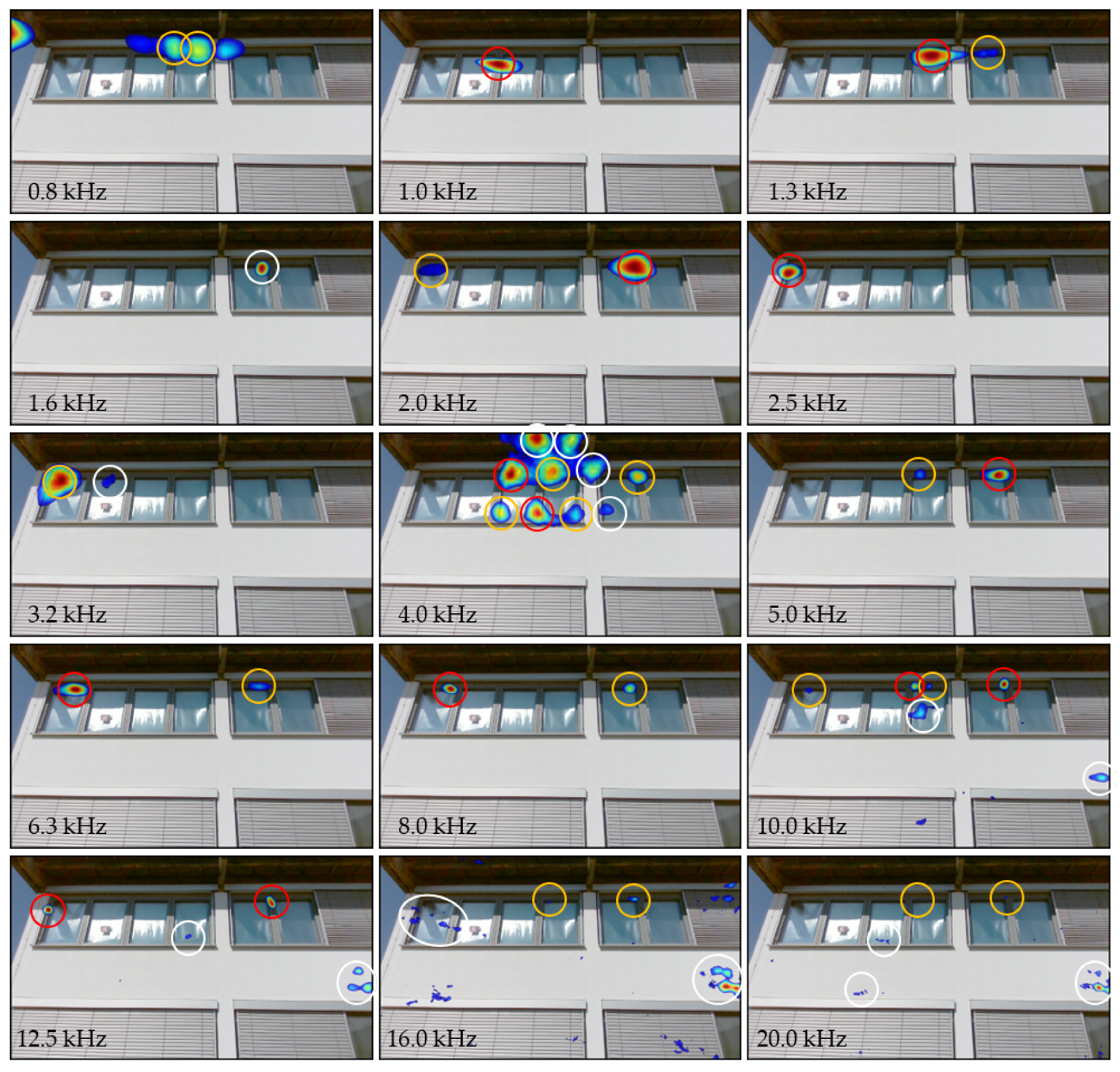
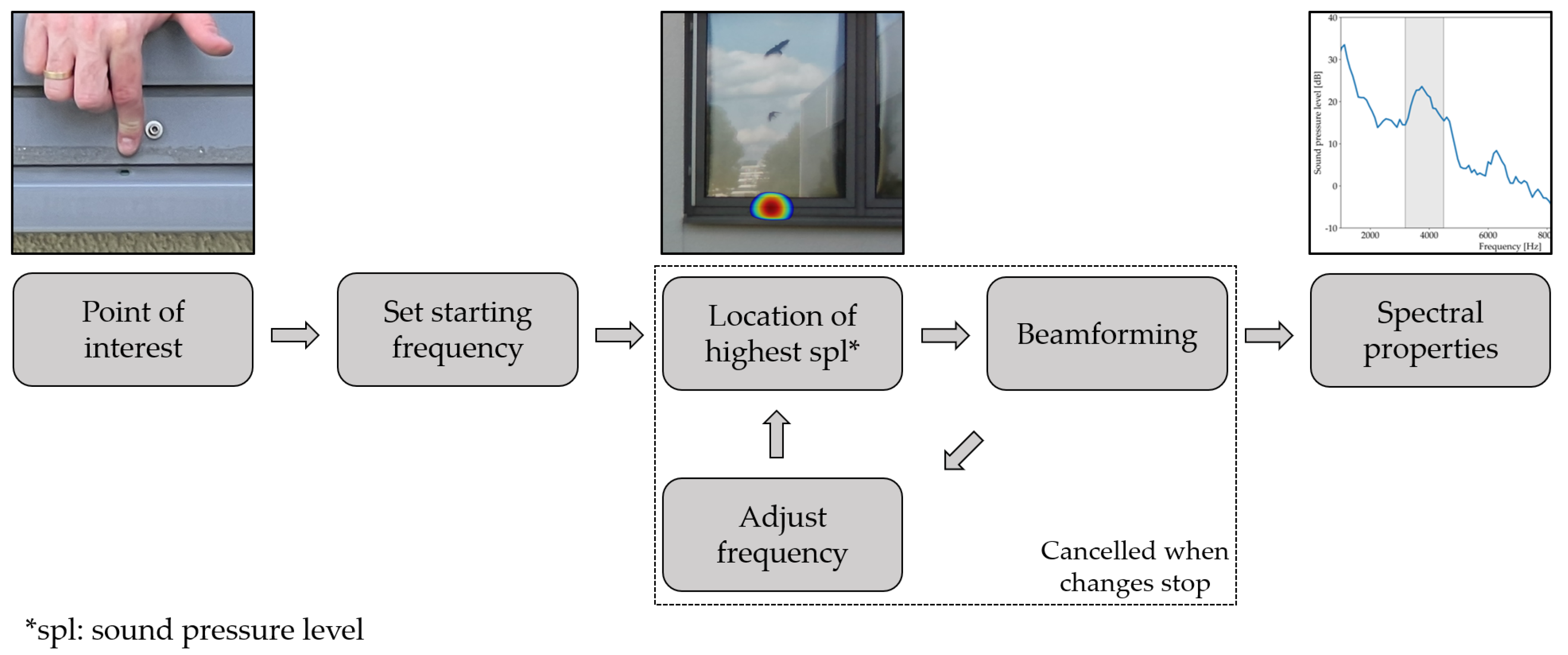
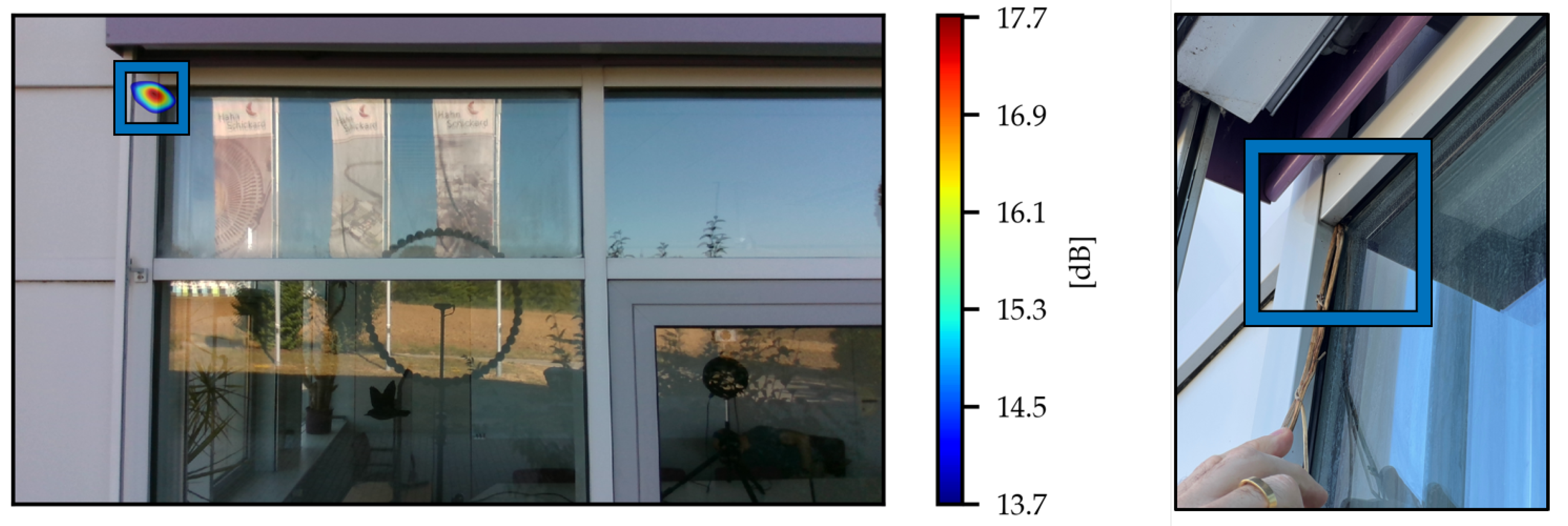
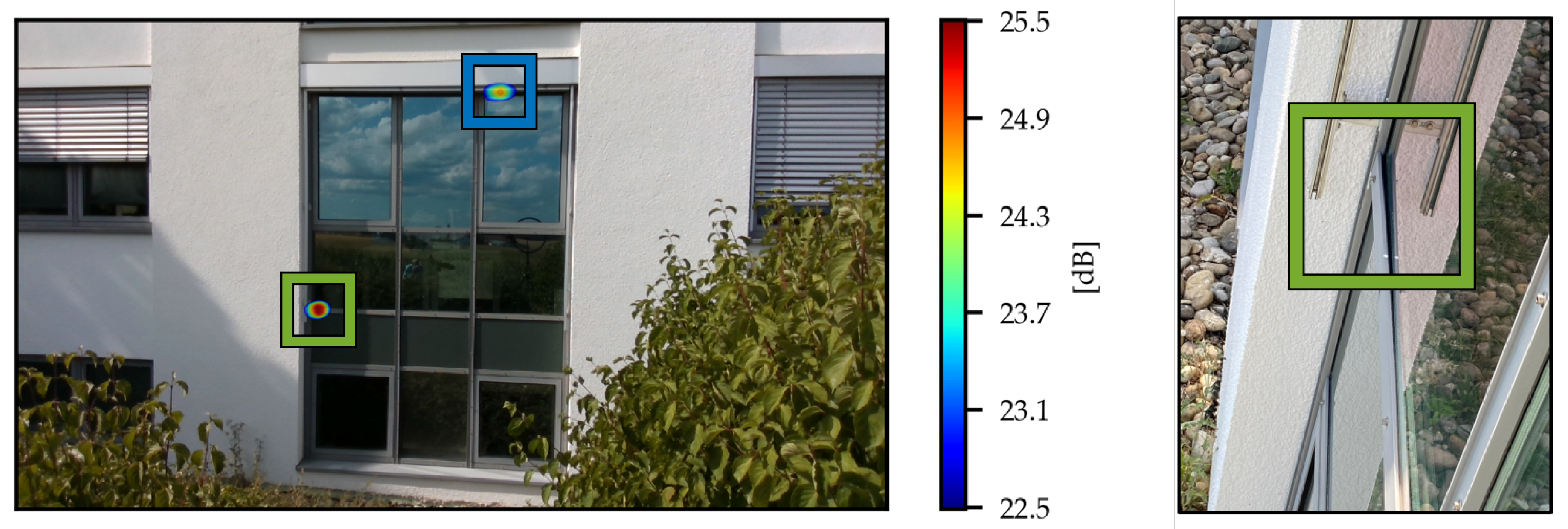


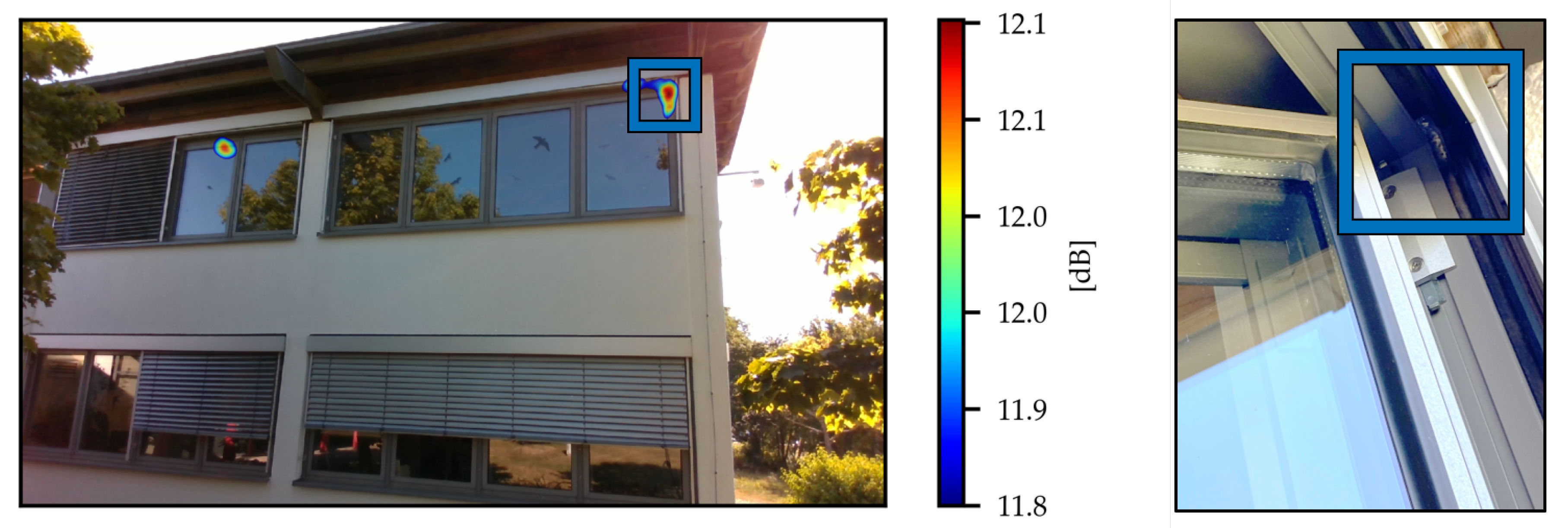
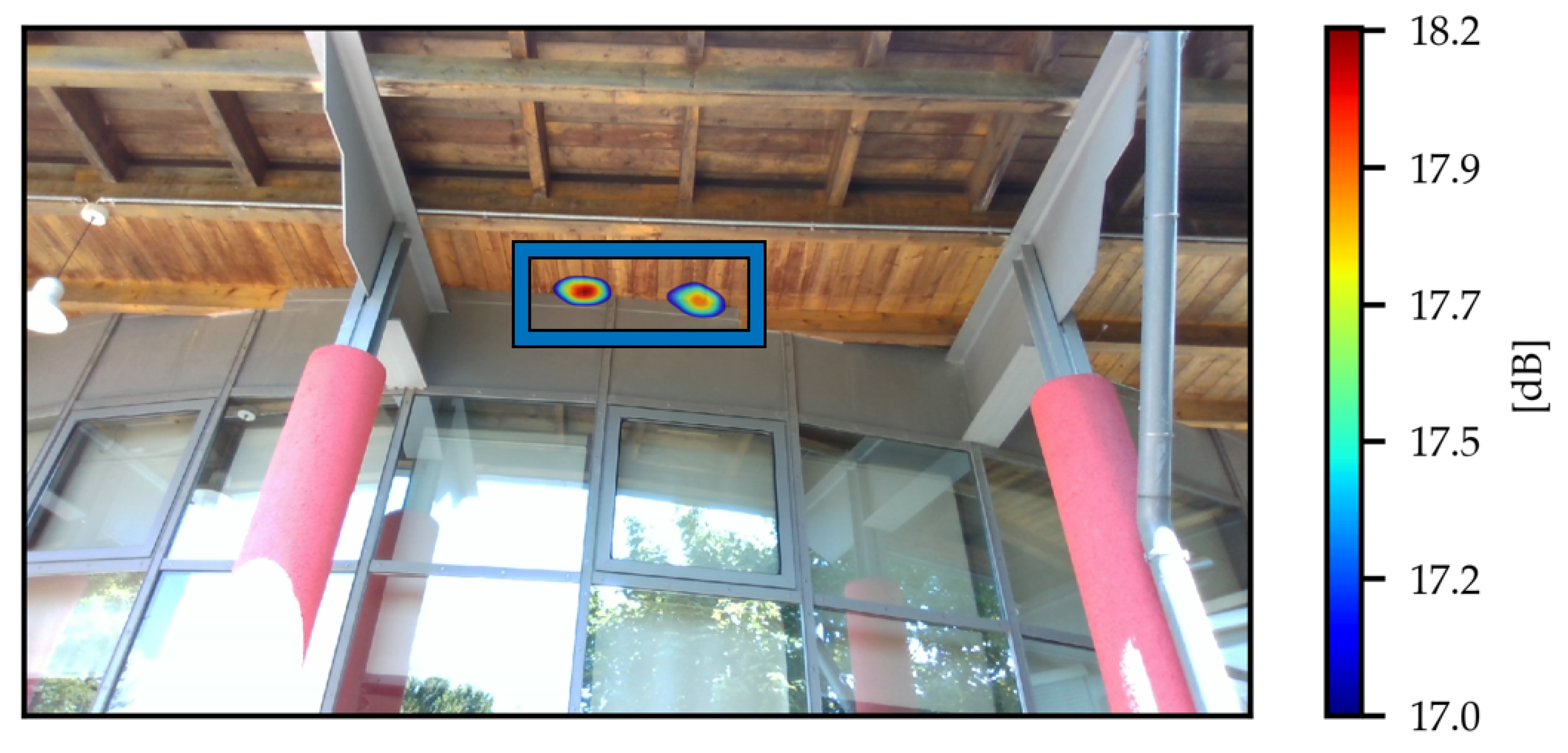

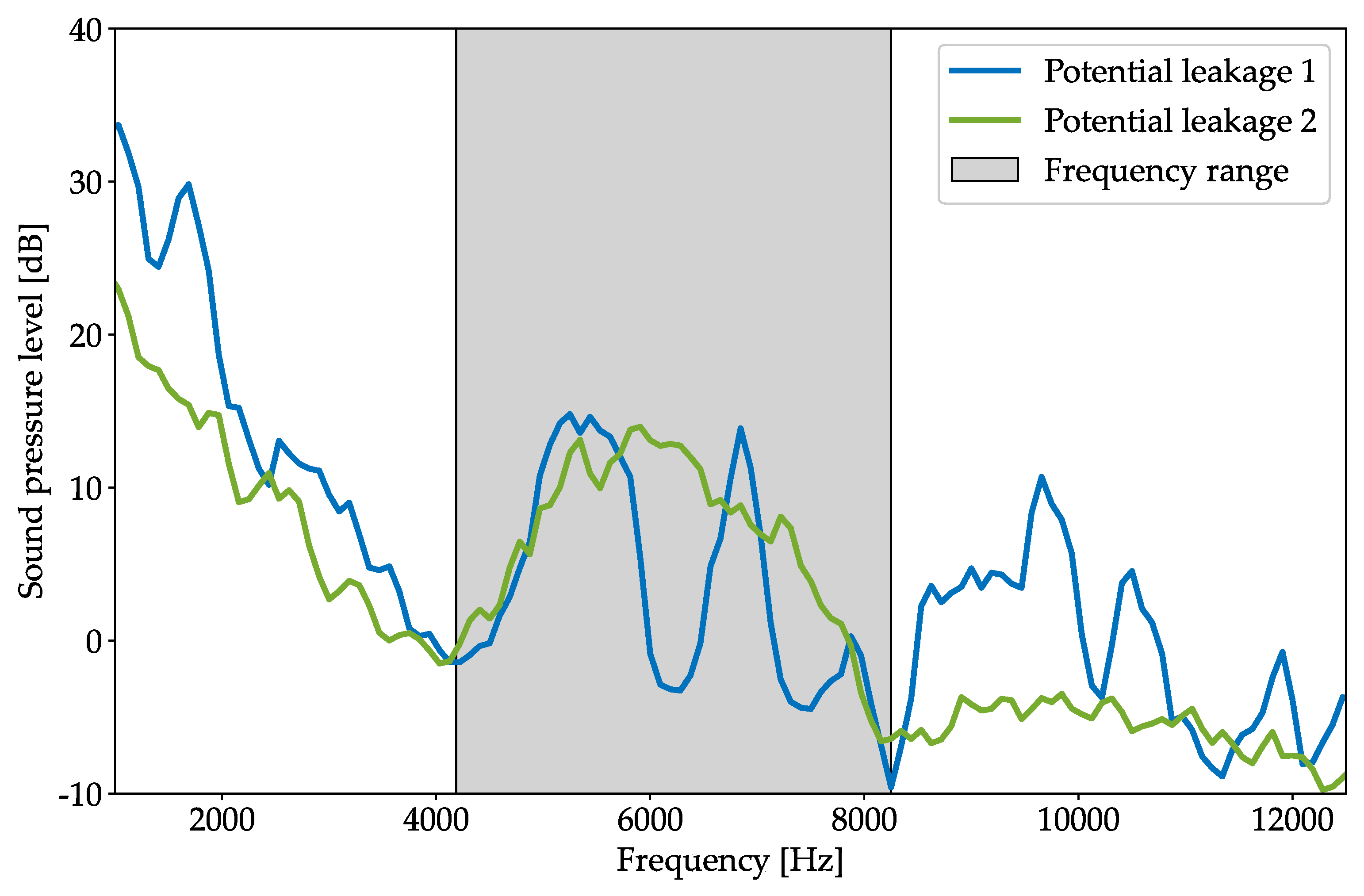

| Colour Code | Acoustic Assessment Score (ASS) | Evaluation of Acoustic Signals | Description of Subjective Criteria |
|---|---|---|---|
 | 0 | Very unlikely leakage | The peak of a signal is at an implausible location (e.g., on a window pane, a façade panel, or outside the area under consideration) |
 | 1 | Unlikely leakage | Some indications that the signal is probably not caused by a leakage (e.g., the widespread shape of the sound source) or the peak of the signal is at a rather implausible location (e.g., close to a plausible location but just off the mark) |
 | 2 | Likely leakage | The peak of the signal is at a plausible location (e.g., the joints between different materials or a roof and wall) or even at a particularly plausible location but has a much weaker signal |
 | 3 | Very likely leakage | The peak of the signal is at a particularly plausible location (e.g., the seals of a door and window frames) |
| Room | Note | MFAS | Third-Octave Frequency Bands in kHz | |||||||||||||||
|---|---|---|---|---|---|---|---|---|---|---|---|---|---|---|---|---|---|---|
| D-112 | S | 12 |  |  |  |  |  |  |  |  |  |  |  |  |  |  |  |  |
| S (up) | 42 |  |  |  |  |  |  |  |  |  |  |  |  |  |  |  |  | |
| SSW | 15 |  |  |  |  |  |  |  |  |  |  |  |  |  |  |  |  | |
| SW (1) | 36 |  |  |  |  |  |  |  |  |  |  |  |  |  |  |  |  | |
| SW (2) | 39 |  |  |  |  |  |  |  |  |  |  |  |  |  |  |  |  | |
| NW | 28 |  |  |  |  |  |  |  |  |  |  |  |  |  |  |  |  | |
| D-112 | NW | 26 |  |  |  |  |  |  |  |  |  |  |  |  |  |  |  |  |
| Corridor | N (1) | 19 |  |  |  |  |  |  |  |  |  |  |  |  |  |  |  |  |
| N (2) | 27 |  |  |  |  |  |  |  |  |  |  |  |  |  |  |  |  | |
| D-109 | 24 |  |  |  |  |  |  |  |  |  |  |  |  |  |  |  |  | |
| D-108 | W | 31 |  |  |  |  |  |  |  |  |  |  |  |  |  |  |  |  |
| S | 35 |  |  |  |  |  |  |  |  |  |  |  |  |  |  |  |  | |
| D-107 | 36 |  |  |  |  |  |  |  |  |  |  |  |  |  |  |  |  | |
| D-106 | S | 36 |  |  |  |  |  |  |  |  |  |  |  |  |  |  |  |  |
| E | 36 |  |  |  |  |  |  |  |  |  |  |  |  |  |  |  |  | |
| D-103 | 19 |  |  |  |  |  |  |  |  |  |  |  |  |  |  |  |  | |
| D-211 | 29 |  |  |  |  |  |  |  |  |  |  |  |  |  |  |  |  | |
| D-210 | 18 |  |  |  |  |  |  |  |  |  |  |  |  |  |  |  |  | |
| D-209 | 33 |  |  |  |  |  |  |  |  |  |  |  |  |  |  |  |  | |
| D-208 | W | 29 |  |  |  |  |  |  |  |  |  |  |  |  |  |  |  |  |
| S | 37 |  |  |  |  |  |  |  |  |  |  |  |  |  |  |  |  | |
| D-207 | 33 |  |  |  |  |  |  |  |  |  |  |  |  |  |  |  |  | |
| D-206 | S | 33 |  |  |  |  |  |  |  |  |  |  |  |  |  |  |  |  |
| E | 38 |  |  |  |  |  |  |  |  |  |  |  |  |  |  |  |  | |
| D-205 | 29 |  |  |  |  |  |  |  |  |  |  |  |  |  |  |  |  | |
| D-204 | 19 |  |  |  |  |  |  |  |  |  |  |  |  |  |  |  |  | |
| D-203 | 29 |  |  |  |  |  |  |  |  |  |  |  |  |  |  |  |  | |
| D-202 | 37 |  |  |  |  |  |  |  |  |  |  |  |  |  |  |  |  | |
| D-201 | 23 |  |  |  |  |  |  |  |  |  |  |  |  |  |  |  |  | |
| Bridge | S | 19 |  |  |  |  |  |  |  |  |  |  |  |  |  |  |  |  |
| N (1) | 18 |  |  |  |  |  |  |  |  |  |  |  |  |  |  |  |  | |
| N (2) | 21 |  |  |  |  |  |  |  |  |  |  |  |  |  |  |  |  | |
| Room | Note | MFAS | Third-Octave Frequency Bands in kHz | |||||||||||||||
|---|---|---|---|---|---|---|---|---|---|---|---|---|---|---|---|---|---|---|
| Office 2 | 3rd floor | 14 |  |  |  |  |  |  |  |  |  |  |  |  |  |  |  |  |
| Office 1 | 2nd floor | 20 |  |  |  |  |  |  |  |  |  |  |  |  |  |  |  |  |
| Office | 2nd floor | 5 |  |  |  |  |  |  |  |  |  |  |  |  |  |  |  |  |
| Office | 1st floor | 8 |  |  |  |  |  |  |  |  |  |  |  |  |  |  |  |  |
| Meeting | 1st floor | 9 |  |  |  |  |  |  |  |  |  |  |  |  |  |  |  |  |
| Meeting 2 | 1st floor | 21 |  |  |  |  |  |  |  |  |  |  |  |  |  |  |  |  |
| Office 1 | 1st floor | 15 |  |  |  |  |  |  |  |  |  |  |  |  |  |  |  |  |
| Office | 1st floor | 24 |  |  |  |  |  |  |  |  |  |  |  |  |  |  |  |  |
| Meeting | 2nd floor | 10 |  |  |  |  |  |  |  |  |  |  |  |  |  |  |  |  |
| Office | 1st floor | 13 |  |  |  |  |  |  |  |  |  |  |  |  |  |  |  |  |
| Room | Note | MFAS | Third-Octave Frequency Bands in kHz | |||||||||||||||
|---|---|---|---|---|---|---|---|---|---|---|---|---|---|---|---|---|---|---|
| A-101 | SW (1) | 12 |  |  |  |  |  |  |  |  |  |  |  |  |  |  |  |  |
| SW (2) | 26 |  |  |  |  |  |  |  |  |  |  |  |  |  |  |  |  | |
| NW | 27 |  |  |  |  |  |  |  |  |  |  |  |  |  |  |  |  | |
| NW | 9 |  |  |  |  |  |  |  |  |  |  |  |  |  |  |  |  | |
| A-103 | 16 |  |  |  |  |  |  |  |  |  |  |  |  |  |  |  |  | |
| A-201/1 | (1) | 3 |  |  |  |  |  |  |  |  |  |  |  |  |  |  |  |  |
| (2) | 13 |  |  |  |  |  |  |  |  |  |  |  |  |  |  |  |  | |
| A-201/2 | 13 |  |  |  |  |  |  |  |  |  |  |  |  |  |  |  |  | |
| A-201/3 | 15 |  |  |  |  |  |  |  |  |  |  |  |  |  |  |  |  | |
| A-202 | NW | 16 |  |  |  |  |  |  |  |  |  |  |  |  |  |  |  |  |
| SW (1) | 16 |  |  |  |  |  |  |  |  |  |  |  |  |  |  |  |  | |
| SW (2) | 19 |  |  |  |  |  |  |  |  |  |  |  |  |  |  |  |  | |
| SW (3) | 12 |  |  |  |  |  |  |  |  |  |  |  |  |  |  |  |  | |
| SW (4) | 11 |  |  |  |  |  |  |  |  |  |  |  |  |  |  |  |  | |
| A-102 | 8 |  |  |  |  |  |  |  |  |  |  |  |  |  |  |  |  | |
| No. of Measurements per Building | |||
|---|---|---|---|
| MFAS | D (1998) | A (1990) | E (2019) |
| very low (0–9) | 0 | 3 | 3 |
| low (10–19) | 8 | 10 | 4 |
| mid (20–29) | 10 | 2 | 3 |
| high (30–39) | 13 | 0 | 0 |
| very high (40–48) | 1 | 0 | 0 |
Disclaimer/Publisher’s Note: The statements, opinions and data contained in all publications are solely those of the individual author(s) and contributor(s) and not of MDPI and/or the editor(s). MDPI and/or the editor(s) disclaim responsibility for any injury to people or property resulting from any ideas, methods, instructions or products referred to in the content. |
© 2024 by the authors. Licensee MDPI, Basel, Switzerland. This article is an open access article distributed under the terms and conditions of the Creative Commons Attribution (CC BY) license (https://creativecommons.org/licenses/by/4.0/).
Share and Cite
Schiricke, B.; Diel, M.; Kölsch, B. Field Testing of an Acoustic Method for Locating Air Leakages in Building Envelopes. Buildings 2024, 14, 1159. https://doi.org/10.3390/buildings14041159
Schiricke B, Diel M, Kölsch B. Field Testing of an Acoustic Method for Locating Air Leakages in Building Envelopes. Buildings. 2024; 14(4):1159. https://doi.org/10.3390/buildings14041159
Chicago/Turabian StyleSchiricke, Björn, Markus Diel, and Benedikt Kölsch. 2024. "Field Testing of an Acoustic Method for Locating Air Leakages in Building Envelopes" Buildings 14, no. 4: 1159. https://doi.org/10.3390/buildings14041159
APA StyleSchiricke, B., Diel, M., & Kölsch, B. (2024). Field Testing of an Acoustic Method for Locating Air Leakages in Building Envelopes. Buildings, 14(4), 1159. https://doi.org/10.3390/buildings14041159







